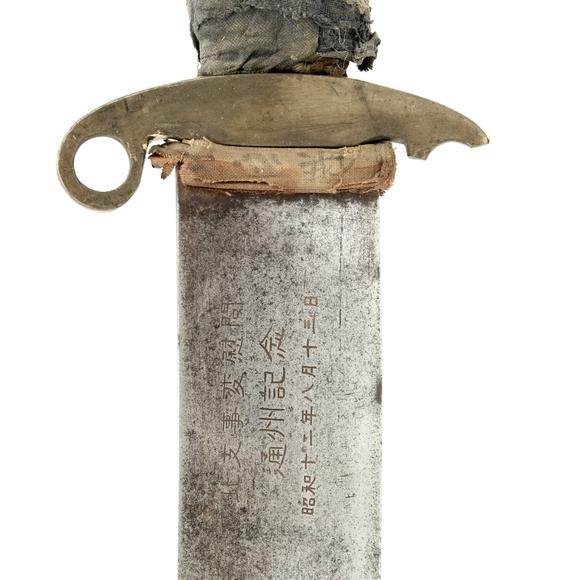Yáng Wéntōng (杨文通) was a Manchu bow maker of the Jù Yuán Hào (聚元號) workshop in Beijing. He succeeded his father Yáng Ruìlín (杨瑞林) and became its 9th generation bowyer.1

Yáng Wéntōng (1928-2006).
About Jù Yuán Hào
Jù Yuán Hào (聚元號) is a bow making workshop in Beijing, founded in 1720. Initially, there were about 40 bowyers in the city but by the late 19th century Jù Yuán Hào was one of the seventeen bowyers left in the imperial bowyer's guild in Beijing.
By the 1960s they were the only shop left in operation, but production seized in 1966 when the shop was closed and its inventory burned by the Red Guards. In 1998, after a hiatus of 32 years, Yáng Fúxǐ (杨福喜) reinstated the brand and is still making bows today.

Jù Yuán Hào in 1935.
Yáng Ruìlín with his young son Yáng Wéntōng.
Communist Era
From 1949 Jù Yuán Hào entered a brief prosperous period fueled by strong demand from mainly outer Mongolia and Qinghai. Three other bowyers from the old guild were still active and filling demands. Sometimes Jù Yuán Hào would outsource bows to them and rebrand them.2

Jù Yuán Hào in 1957.
Yáng Ruìlín (杨瑞林) is in the front, left.
Young Yáng Wéntōng (杨文通) behind him, left.
The rest appear customers from Qinghai (with hat) and Mongolia.
Roaring 50s
In 1958 Mao Zedong launched the "Four Pests" campaign, an attempt to eradicate rats, flies, mosquitoes, and sparrows. This caused an enormous demand for pellet crossbows and the shop had a hard time filling demands.3
They became one of the first joint state enterprises, called "Number One Sporting Goods Co-operative", and later "Beijing Number One Sports Goods Factory" (北京第一体育用品厂). The Party asked them to make a bow to the highest standards.
Yáng Wéntōng (9th generation) worked 40 days on this particular bow, it was made with white translucent horn bellies and its back was finished with traditional designs of bats and flowers. It turned out to be for Mao Zedong himself, who was very pleased with it.4
Cultural revolution
This didn't save the shop. In 1966 the same Mao Zedong launched the Cultural Revolution which was set to purge traditional elements of Chinese society, specifically the sì jiù (四舊) or "Four Olds"; Old Customs, Old Culture, Old Habits, and Old Ideas.
This meant cutting off all traditional lineages of craftsmen. The shop suffered a great blow during this time. In a raid by the Red Guards, the shop sign, written in the hand of the Qianlong emperor was destroyed along with the shop's administration, going back to the Qianlong period, and all inventory of bows, arrows and raw materials.5
Recent time
In the 1990s Yáng Wéntōng took some bows he made to Chinese archery competitions and drew a lot of attention. His son, Yáng Fúxǐ , became interested in picking up the trade. 1998, Yáng Fúxǐ restarted work in a small workshop in Chaoyang area, Beijing. On 26 October 2003 Yáng Wéntōng addressed an audience in Hong Kong with a lecture on The Chinese Bowmaker’s Craft, organized by Stephen Selby, founder of ATARN.org. He also participated in a documentary film for the exhibition Archery Traditions of Asia, featuring large part of the Stephen Selby collection in the Hong Kong museum of Coastal Defense.6
In 2006, just after Yáng Wéntōng's passing, the shop was recognized as China's national intangible cultural heritage (中国国家级非物质文化遗产).7
Yáng Wéntōng's work
There is a bow formerly in the Dr. Charles E. Grayson collection now in the Museum of Anthropology of Missouri, accession number MAC 1994-0668. Grayson’s notes state that the bow was made in the 1950’s by Yang Wentong, and subsequently used in Mongolia for archery tournaments until the 1960s. It's covered with snakeskin and bark.
Another bow by his hand was acquired by Mandarin Mansion in 2020.

A typical example of a Jù Yuán Hào bow of the 1950s made by Yáng Wéntōng.
Decorated with snakeskin, communist stars, doves, and bright pigments.
Sold by Mandarin Mansion in 2020.
Additional photos of the shop

The shop in the 1950s.
Yáng Wéntōng (left), Yáng Ruìlín (right).
Notice the style of bows on the right.

Yáng Ruìlín in the shop in the 1950s.

The late Yáng Wéntōng (left) with Yáng Fúxǐ (right).
1990s.
Notes
1. Interview with the last successor of Ju Yuan Hao, (专访“聚元号”传人杨福喜 弓箭行最后的手艺人) by Liu Xinyin. (Chinese)
2. The History of Ju Yuan Hao Bowmakers of Beijing, anonymous author. Translation by Stephen Selby for ATARN.org.
3. Ibid.
4. Ibid. and Interview with the last successor of Ju Yuan Hao, (专访“聚元号”传人杨福喜 弓箭行最后的手艺人) by Liu Xinyin. (Chinese)
5. Ibid. and Ju Yuan Hao, Chinese Baidu article, and Ju Yuan Hao, Chinese Wikipedia article.
6. See the draft storyboard with photos of him at work at ATARN.org
7. Ju Yuan Hao, Chinese Wikipedia article.






